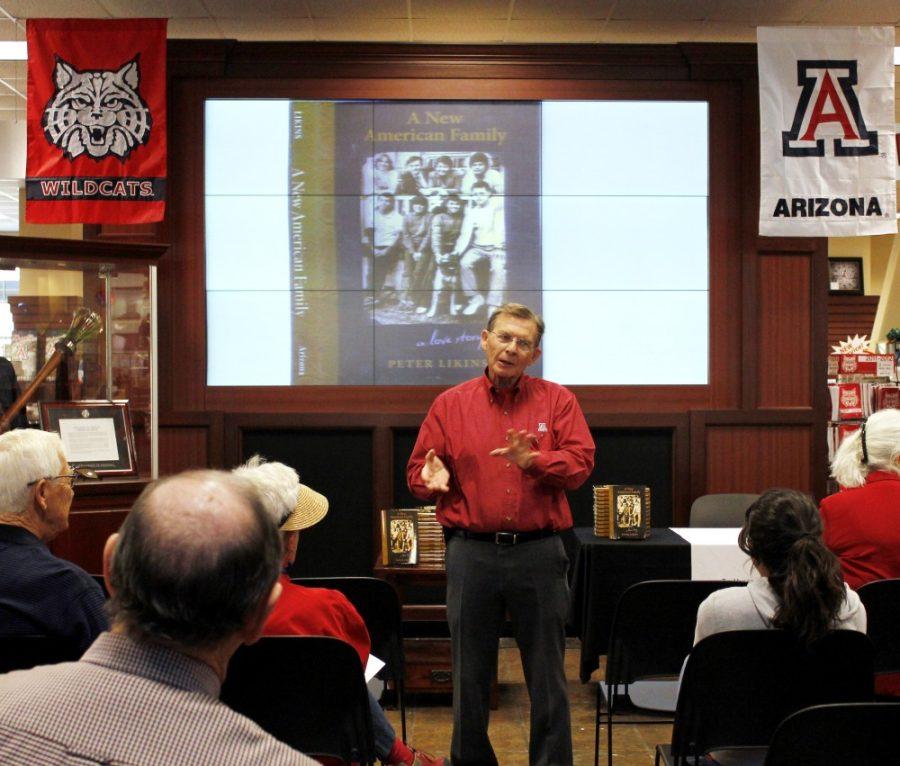After earning a master’s and doctoral degree at Stanford University and a master’s degree from the Massachusetts Institute of Technology, UA President Emeritus Peter Likins went on to serve as an engineering professor at the University of California, Los Angeles, a dean and provost at Columbia University, and president of Lehigh University before moving to Tucson. But it all started when he and his wife Patricia adopted six children; a boy and a girl of black and white descent, two American Indian sisters, a white daughter and a Hispanic son. Now 75, Likins tells his life story in his memoir, “A New American Family: A Love Story.” He appeared at the UofA Bookstore on Saturday for a signing.
Daily Wildcat: Growing up in Santa Cruz, California, how would you describe your family and experiences? Would you describe your family growing up as the “old” American family?
Peter Likins: My family growing up in Santa Cruz, California, was broken, poor and not in any sense a model of the American family as it was conceived in our imagination for the 1950s. My father took off when I was 7 and left my mother in desperate straits, and she was just struggling to try to hold the family together in a two-room, cold-water cabin in the mountains outside of Santa Cruz. We understood from the very beginning that education was the path to prosperity.
You married when you were 19 years old, had a Bachelor’s degree from Stanford by 20, then a master’s degree from MIT at 21. How did you feel, and how did you manage your life during this time?
I was blessed with certain talents that enabled me, with hard work, to accomplish goals earlier than most. I didn’t have a good sense of myself in college. I had very good grades, but I remember my faculty adviser once asked me if I ever thought about being a college professor, and it never occurred to me that I could be a college professor. Only with my master’s adviser at MIT did I begin to wonder if I could maybe do this. So I was kind of gradually coming to an understanding of myself during those years.
In your early 20s, you and your wife began adopting children. Can you go through that process chronologically?
While I was still a graduate student at Stanford, we adopted our first child. We identified a second child, whom we adopted just a couple of months into my first employment as an acting assistant professor of engineering at UCLA. Our third child was black, and that was a really shocking change for the world to see. My wife saw this child on television through a program called “Adoption Interviews.” Once you have one black child and you’re a white couple in a white neighborhood, it’s really important to have a second black child. So we deliberately adopted our fourth child. Then my wife watched that damn TV show one more time and she saw Teresa, an American Indian child in foster care whose parents had both died. That 10-year-old, in coming to us, said, “Will you please adopt my sister, too?” So we adopted her sibling. That’s where the six all came together.
You dealt with several challenges during this process. Describe those challenges, and how dealing with them has affected you, your family and your career.
In my personal perspective, coping with the challenges presented by our children helped me enormously as a university president. I know that I was more effective in dealing with black kids, for example, because all through my life as a university faculty member, dean and president, I had black kids of my own. When you love individual human beings who are in these special categories, the categories just become irrelevant.
In the midst of all this, you were moving quite a bit. You went from UCLA to Columbia University, and then from Columbia to Lehigh University. Explain how you did that with such a large family.
There was one move that was, from the kids’ perspective, really critical, and that was the move from UCLA to New York. They were then in a pre-high school state. When I first was approached by Columbia, I thought, “Well I can’t uproot my kids, my wife. We’re California people. How can we go to New York?” But my wife said, “Let’s go,” and so we took off. For them, it was a great adventure. And again, it’s the solidarity of the family unit that makes that possible.
What does it mean to you to be the “featured author” at this year’s Homecoming?
It’s very gratifying. Since the book was published nine months ago, I’ve made about a dozen presentations on the book in Arizona, Pennsylvania, New York and California, but this is home. When the UA Alumni Association includes me in this way and allows me to be their representative at Homecoming, it’s very heartwarming.
To what extent do you believe that your family is a “new American family”? Would you consider your family to be the epitome of this idea?
Demographically, America is changing. We’re going to have to rethink what an American looks like, and maybe come to the understanding that we’re all Americans. I believe that, at least demographically, my family, in some sense, portends to what America is going to look like. That’s what the new American family is all about.









